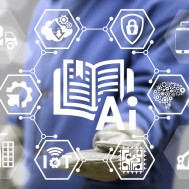“Companies need to become digital to survive” Jeff Immelt, GE’s previous CEO, told Business Insider. “We must turn information into insights and insights into outcomes.”
That implies something drastic:
Manufacturing isn’t what it used to be. Which isn’t a bad thing. But it could prove difficult to keep up to date with the latest industry trends if we don’t keep an open mind. And though we look to embrace digital technology, one trend in particular should be our focus:
Artificial Intelligence.
It exponentially advances our industry, making a profound impact in it. However, coming to terms with that fact can be intimidating. This is often due to a lack of awareness. Or, a fundamental misunderstanding of AI.
Which is where we come in. And hope to help. First, let’s define what artificial intelligence actually is.
What is Artificial Intelligence?
Simply put, artificial intelligence is the reasoning and processing capabilities of certain machines. In essence, these machines are built to mimic the cognitive process of humans through the implementation of AI processes. But they’re not here to replace us.
In fact, artificial intelligence is rooted in the idea of creating machines that are as efficient as possible for people like us. It’s created as means to assist us in learning and problem solving, while in turn learning and solving problems on it’s own. It grows just as we do. And at it’s best, artificial intelligence allows us and our businesses to achieve our full potential.
Just take a look at what some businesses have already done.
Decrease unplanned downtime
Unplanned downtime is, plainly, a term used to describe a time period in which a network or server is offline. This is different than, let’s say, a routine maintenance check because of the notion of planning.
P&G, however, may not have to put too much concern into it anymore.
The company has decreased their unplanned downtime by 10 to 20 percent through the implementation of Brilliant Manufacturing, a software suite primarily rooted in artificial intelligence and intrinsically driven to facilitate efficiency. The program offers P&G enhanced analytics, as well as the ability to optimally connect all phases of their business development.
Analyze industrial variables
A global leader in manufacturing, Siemens actively searches for ways to maintain their standing in our industry. In fact, for the past 30 years, the company has been researching ways to do it. And the answer they’ve found? Conveniently, artificial intelligence.
Specifically, MindSphere, their custom AI system — and it’s ability to not only analyze industrial facilities, but also to be applied widespread throughout the majority of Siemens’ departments.
According to their website, and in the context of Siemens’ rail-energy research, MindSphere also “significantly reduces the emission of toxic nitrogen oxides without affecting the performance of the turbine or shortening its service life.”
Solves problems efficiently
This computing manufacturer processes a great deal of data every day. For any company, this is a difficult task. However, for Fujitsu, the implementation of AI makes it relatively easy.
With 864 rows of over 88,000 computers, one wouldn’t argue Fujitsu’s efficiency. But with knowledge of each individual computer having the ability to make close to 10.5 trillion calculations per second, the company’s efficiency isn’t questioned. In fact, this level of performance is what continues to propel Fujitsu to the top of the manufacturing industry.
Advances technological knowledge
At Hitachi, manufacturers’ primary objective is to instill knowledge. So much so, that their use of artificial intelligence involves the notion of instilling knowledge in more than just their target demographic. Specifically, this is seen in their understanding and application of deep learning. And their robots.
Deep learning is the implementation of neural networks to both simple and complex machines. And as Hitachi grows in their understanding of it, their goal of allowing machines to do the same does, too. Just take a look at their Swing Robot.
Designed with working neural networks, it first analyzed an immense amount of data. From there, it took about 5 minutes, without human intelligence, to figure out how to swing effectively. It sounds like it’s right out of a movie, but it’s true. AI is beginning to teach itself, which will be beneficial to us all.
Artificial intelligence in manufacturing: What’s next?
Does your manufacturing plant utilize artificial intelligence? What advantages/disadvantages have your found? We’d like to hear about it. Let us know by tweeting us at @AppleRubber.
